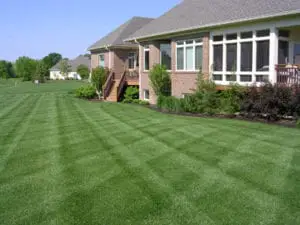
It's difficult to envision the perfect lawn during the first week of February in Indianapolis, but in reality, your lawn's health begins in the next few weeks. The snow will melt and the weather will get warmer and your lawn will wake up and begin to grow. But how do you create the perfect lawn? Your lawn's health is dependent on several factors. Some you can control and some you cannot. The perfect lawn is the result of continuous care and attention. Fertilization - Fertilizer is food. Your lawn needs food, and just like a person, a lawn needs food on a measured and controlled schedule. You can't eat once a week or once a month. And your lawn can't eat once a season. Our 7-application program provides a measured amount of food for your lawn to feed on all season long. Mowing - A sharp blade is critical. Have your blade sharpened at the beginning of each season and check it every month or so and resharpen as needed. Some homeowners love short grass. But short grass is not healthy. Grass should not be mowed shorter than 3 inches. 4 inches is the ideal height as it helps choke out weeds. If grass is growing fast, mow often. Water - A lawn needs 1-2 inches of water per week. If it's not raining, then you should water the lawn in the mornings. Try to avoid watering more than twice a week. Water deeply as it allows the grass roots to grow deep into the soil. Weed control - A healthy lawn naturally resists weeds. But if you don't water, don't fertilize and mow your grass short, then you create a haven for weeds. Our 7-app program includes several rounds of weed control to help fight the leafy invaders all season long. Shade - Grass doesn't grow well in shade. Heavy shade creates thin grass and allows weeds to invade. Trees can be pruned to allow more sunlight through, but if that isn't practical, then perhaps the shaded area can be mulched and filled with shade-loving plants. We'll dive into each of these topics in more detail as Spring approaches, so come back to learn more.
